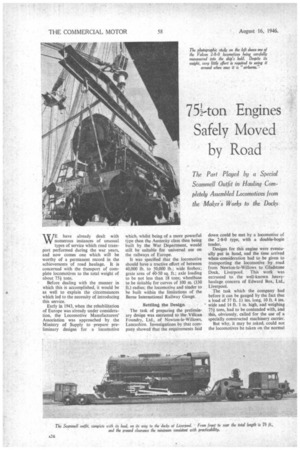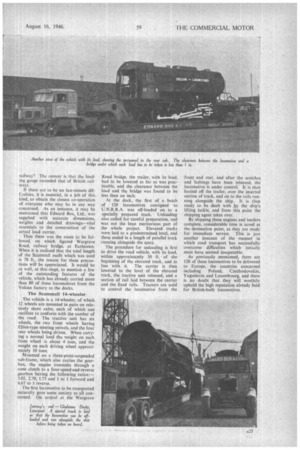75-ton Engines Safely Moved by Road
Page 28

Page 29

If you've noticed an error in this article please click here to report it so we can fix it.
WE have already dealt with numerous instances of unusual types of service which road transport performed during the war years, and now comes one which will be worthy of a permanent record in the achievements of road haulage. It is concerned with the ttansport of complete locomotives to the total weight of about 75i tons.
Before dealing with the manner in which this is accomplished, it would be as well to explain the circumstances which led to the necessity of introducing this service.
Early in 1943, when the rehabilitation of Europe was already under consideration, the Locomotive Manufacturers' Association was approached by the Ministry of Supply to prepare preliminary designs for a locomotive which, whilst being of a more powerful 1iTle than the Austerity class then being built by the War Department, would still be suitable for universal use on the railways of Europe.
It was specified that the locomotive should have a tractive effort of between 40,000 lb. to 50,000 lb.; wide firebox; grate area of 40-50 sq. ft.; axle loading to be not less than 18 tons; wheelbase to be suitable for curves of 100 m. (330 ft.) radius; the locomotive and tender to be built within the limitations of the Berne International Railway Gauge.
Settling the Design.
The task of preparing the preliminary design was entrusted to the VtlIcan Foundry, Ltd., of Newton-le-Willows, Lancashire. Investigations by that company showed that the requirements laid down could be met by a locomotive of the 2-8-0 type, with a double-bogie tender.
Designs for this engine were eventually put in hand, and the time arrived when consideration had to be given to transporting the locomotive by road from Newton-le-Willows to Gladstone Dock, Liverpool. This work was entrusted to the well-known heavyhaulage concern of Edward Box, Ltd., Liverpool.
The task which the company had before it can be gauged by the fact that a load of 37 ft. 11 ins. long, 10 ft. 4 ins. wide and 14 ft. 1 in. high, and weighing 75i tons, had to be contended with, and this, obviously, called for the use of a specially constructed machinery carrier.
But why, it may be asked, could not the locomotives be taken on the normal
railway? The answer is that the loading gauge exceeded that of British railways.
If there are to be no last-minute diff alines, it is essential, in a job of this kind, to obtain the closest co-operation of everyone who may be in any way concerned. As an instance, it may be mentioned thAt Edward Box, Ltd., was supplied with accurate dimensions. we.ghts and detailed drawings—vital essentials to the construction of the actual load carrier.
Then there was the route to be followed, on which figured Wargrave Road, railway bridge. at Earlstown. When it is realized that the total length of the Scammell outfit which was used is 78 ft., the reason for these precautions will be appreciated. It would be as well, at this stage, to mention a few of the outstanding features of the vehicle, which has already carried more than 80 of these locomotives from the Vulcan factory to the dOcks.
The Scanunell 14-wheeler • The vehicle is a 14-wheeler, of which 12 wheels are mounted in pairs on relatively short axles, each of which can oscillate to conform with the camber of the road. 1 he tractive unit has six wheels, the two front wheels having Elliot-type steering swivels, and the four rear wheels being driven. When carrying a normal load the weight on each front wheel is about 4 tons, and the weight on each driving wheel approximately 10 tons.
Mounted on a three-point-suspended sub-frame, which also carries the gearbox, the engine transmits through a cone clutch to a four-speed-and-reverse gearbox having the following ratios:5.03, 2.70, 1.75 and 1 to 1 forward and 6.67 to 1 reverse.
The first locomotive to be transported naturally gave some anxiety to all concerned. On arrival at the Wargrave Joarneis end — Gladstone Docks, Liverpool. A special track is laid so that the locomotive can be offloaded and run alongside the ship before being taken on board. Road bridge, the trailer, with its load, had to be lowered as far as was practicable, and the clearance between the load and the bridge was found to be less than an inch.
At the dock, the first of a batch of 120 locomotives consigned to U.N.R.R.A. was off-loaded on to a specially prepared track. Unloading also called for careful preparation, and was not the least meritorious part of the whole project. Elevated tracks were laid to a predetermined level, and these ended in a length of parallel track running alongside the quay.
The procedure for unloading is first to drive the road vehicle, with its load, within approximately 30 ft. of the beginning of the elevated track, and in line With it. The carrier is then lowered to the level of the elevated track, the tractive unit released, and a section of rail laid between the carrier and the fixed rails. Tractors are used to control the locomotive from the
front and rear, and after the scotches and lashings have been released, the locomotive is under control. It is then hauled off the trailer, over the inserted section of track, and on to the rails running alongside the ship. It is then ready to be dealt with by the ship's lifting tackle, and from this point the shipping agent takes over.
By shipping these engines and tenders complete, considerable time is saved at the destination point, as they are ready for immediate service. This is just another instance of the manner in which road transport has successfully overcome difficulties which initially must have. seemed insuperable.
As previously mentioned, there are 120 of these locomotives to be delivered to Europe, the countries concerned including Poland, Czechoslovakia, Yugoslavia and Luxembourg, and there is no doubt that they will worthily uphold the high reputation already held for British-built locomotives.




































































